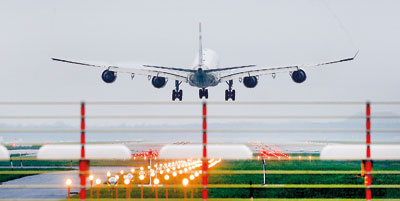Sunday Times 2
Have a safe flight: Aviation industry flies high
The Convention on International Civil Aviation Day emerged on December 7, 1944, at the end of a well-attended international conference in Chicago, USA, with 52 signatories. It laid the foundation for the establishment of the International Civil Aviation Organisation (ICAO) which later became a United Nations Agency specialised in civil aviation.
Today, ICAO celebrates its 70th birthday with a membership of 191 states that have subscribed to the Chicago Convention, as it is popularly known.

An aircraft lands at Munich's airport: Over the past 70 years, air transport has become the safest, expeditious, efficient, regular, economical and environmentally friendly mode of transport
ICAO is governed by a council of 36 states elected from amongst its members through a ballot conducted at its assembly held every three years. The Chief of the ICAO is the council’s president. To facilitate smooth functioning and effective coordination with member-states, ICAO has established seven regional offices. It has also set up a few commissions on different subjects, involving member states serving the council. The ICAO’s workhorse is the secretariat which is administered by the secretary-general with the assistance of directors, regional directors and more than 800 employees.
The organisation aims to develop the principles and techniques of international air navigation and to foster the planning and development of international air transport to ensure the safe and orderly growth of international civil aviation throughout the world. It aspires to encourage the arts of aircraft design and operation for peaceful purpose and the development of airways, airports, and air navigation facilities for international civil aviation. It intends to meet the needs of people for safe, regular, efficient and economical air transport as well as prevent economic waste caused by unreasonable competition, among other things.
Over the past 70 years, air transport has become the safest, expeditious, efficient, regular, economical and environmentally friendly mode of transport with ICAO playing a vital role in achieving this status quo.
There are currently more than 10,000 International Standards and Recommended Practices (SARPs) relating to civil aviation adapted by ICAO for the implementation by the member-states. The organisation’s statistics show that there are 26,000 commercial aircraft operated by 1,397 commercial airlines into and out of 3,864 airports navigating in airspace controlled by 173 Air Navigation Service Providers. These airlines have operated nearly 33 million flight carrying 3.2 billion of passengers and 51 million tones of air cargo in 2013 registering an average annual growth of 5 per cent.
Around one thousand aircraft are retired annually whilst about 1,300 new aircraft join the world’s aircraft fleet. ICAO predicts that the present demand for air travel will double by 2030. Consequently, it is estimated that the industry would require 250,000 new pilots, 400,000 new aircraft maintenance engineers and 40,000 new air traffic controllers, in addition to the requirements for replacement of the retired personnel.
Economic growth and falling ticket prices expressed in real terms are the main drivers of air traffic growth. While economic growth is largely determined outside the industry, airfares reflect many factors that are determined mostly by the industry environment. Cost of air transport has come down remarkably since inception. Over the past decades, better aerospace technology has allowed airlines to increase their management efficiencies, thereby enabling them to lower their costs albeit unprecedented increase in fuel prices.
As a result, passengers have been the greatest beneficiaries. A parallel liberalisation of aviation markets, resulting in increased airline competition, has ensured that customers benefit from lower airline costs through lower ticket prices. A decrease in fares has encouraged people of all incomes to travel more, causing a growth in air travel demand significantly larger than what economic growth alone would have created. .
The profit margin has been very small for commercial airlines. Despite some consistently profitable exceptions, most airlines have performed poorly for investors. Average operating margins of airlines remained below 4 per cent showing insufficient levels to cover overheads, generate a profit, or attract new capital. Intense price competition under liberalised regimes, including those from LCCs, coupled with increasing and widespread use by consumers of low fares rendered by internet search engines, have contributed to the reduced earnings.
Sri Lanka’s civil aviation industry kicked off December 25, 1912 with the first successful flight being performed at the Colombo racecourse. Having acceded to the Chicago Convention, Sri Lanka became a member state of the ICAO on June 1, 1948.
Sri Lanka is obliged to ensure that the SARPs adopted by the ICAO are consistently implemented locally. The State is expected to establish an effective safety oversight system which would actively engage in the initial certification of every entrant (airlines, airports, training organisations, aeronautical service providers, personnel etc) to the civil aviation industry. There must also be continuous monitoring of their activities post certification aiming at safe, secure, efficient and regular operation of air transport.
In 1997, ICAO found Sri Lanka seriously lacking in the discharge of State’s obligations under the Convention. The Government then took a series of measures to rectify the situation. The establishment of the Civil Aviation Authority of Sri Lanka in 2002, abolishing the Department of Civil Aviation, is a direct consequence of such measures.
ICAO conducted three more audits on the Safety Oversight capabilities of Sri Lanka in 2000, 2004 and 2010 following the initial audit and Sri Lanka demonstrated over 87.2 per cent of effective implementation of the SARPs. The country took first place in South Asia and fourth place amongst other States in the Asia and Pacific region. It also ranked 19th in the world.
ICAO has established five Regional Safety Groups in the globe for the promotion aviation safety through cooperation. Sri Lanka has been elected to chair the Regional Aviation Safety Group of the Asia and Pacific Region (RASG-APAC). Sri Lanka is also serving as the second chair of the Asia and Pacific Air Navigation Planning and Implementation Regional Group (APANPIRG) and the second chair of the Regional Aviation Security Forum of the Asia and Pacific Region.
(The writer is Director General of Civil Aviation and Chief Executive Officer of Civil Aviation Authority of Sri Lanka.)

